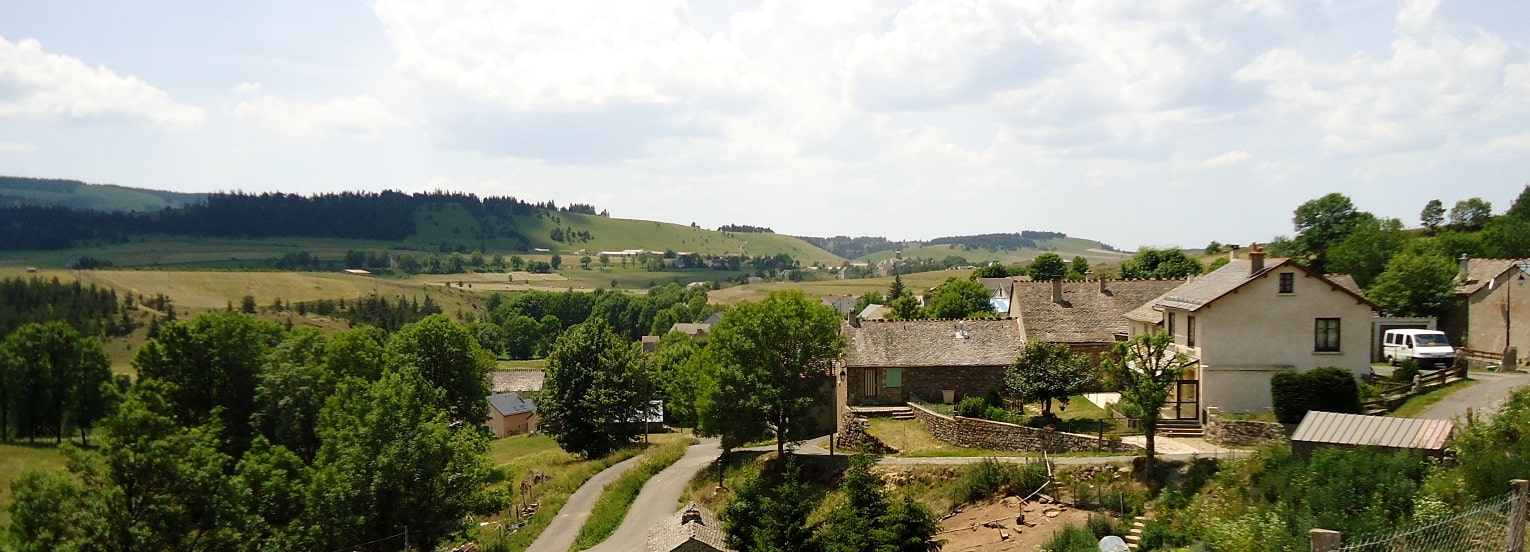
|

|

|
La Margeride is in the north-east of the department, wedged against the Aubrac to the west. It is a region of granite where the relief was shaped during the Precambrian. Once part of the county of Gevaudan, it is full of an eventful history. Dense forest alternates with wild moorland, grassland and pastures at a height of 1000 to 1500 m. altitude.
Impressive blocks of time-worn granite are set down here and there , as if by magic, making a strange and chaotic landscape with stones heaped up into oval or round mounds scattered around the moors or in the woods. This granite used for the rough sturdy dwellings rooted into the high plateaux adds even more charm to the region.
La Margeride is a secretive place, a place of quiet and murmurs. Its highlights are its little network of routes and above all its countless streams and rivers such as the Truyere , prized by fishermen, and also the cover of heather and narcissus in season. This is an environment of infinite richness, well-preserved and welcoming, an invitation both to relaxation and outdoor activity. From Marvejols to Langogne. Le Malzieu to Chateauneuf-de-Randon, the land of Lozere offers you all the serenity of an unspoilt region.
Standing tall in the great amphitheatre overlooking the Mediterranean, the Lozere is the first to receive the warms rays of the sun in Occitanie. Walkers here can feel the deep but gentle excitement of closeness to the skies embracing the rounded summits of Mont Lozere, La Margeride and the Cevennes (Stevenson Trail GR®70, GR®7, GR®72, GR®68). They discover the sweet spring waters of the gorges of the Tarn and the Jonte in one of the most beautiful natural sites in Europe.
For Lozere abounds in natural diversity and landscapes sculpted by its geological history The limestone of the great Causses of Sauveterre and Mejean was used to build vaulted farmhouses of perfect proportions. The volcanic basalt of the Aubrac was the material for the huts where shepherds sheltered and milked their sheep when the west wind blew. The evidence left by our building ancestors is legion here - Gallo-Roman vestiges, now restored, the Gothic cathedral of Mende, the Romanesque churches of La Margeride, the Protestant churches of the Cevennes, plain bread ovens and village crosses - the mark of mankind is stamped throughout the history of the Lozere.
Though it is now it is open and accessible to all of Europe by up-to-date means of communication, Lozere remains a natural preserve where a population of 73, 000 confronts its future by combining tradition with modernity; the peasant farmers carry on the custom of mountain agriculture by growing crops based on quality labels; the craftsmen work wood and stone and all those who receive visitors, innkeepers, campsites, gite owners - provide warm hospitality and an insight into the love they have for their region.
Whether you seek active discovery or well-being by getting back to nature, a family holiday or a weekend break to get away from it all , in the Lozere you will find an unaffected welcome.
The Tarn rises at 1600 metres on the Mont Lozere. It's course teems with torrential streams and over the millennia since the Quaternary the river has cut deeply into the plateaux of the Mejean and Sauveterre: no less than a canyon has been carved into the limestone massif of the Grands Causses. From lspagnac to Rozier the Gorge of the Tarn alternates between clear calm waters (planiols) and bubbling rapids (rajols). The rocky outlines, cliff faces and underground springs which well up all contribute to the extraordinary beauty of this deep corridor with its high walls of up to 500 metres in height, As it winds through 53 kilometres of towns, villages and hamlets, it displays a parade of cirques and boulder fields.
The gorge of the Jonte, a tributary of the Tarn rising on Mont-Aigoual, displays 20 kilometres of equally beautiful landscape from Rozier to Meyrueis. On the heights either side of the Tarn are the Grands Causses. At a height of 1000m, Causse Mejean opens onto a vast steppe of yellow grassland as fascinating as the desert. It's landscapes dotted with typical hamlets of shingled roofs and shepherds huts rise and fall as far as the eye can see.
Causse of Sauveterre is a less arid limestone plateau with hilly land in the south-east. Alongside it is the valley of the Lot, the most fertile region, and known as the "granary" of the Lozere, This valley crosses the department from east to west, from La Canourgue to the Goulet (Mont Lozere) where the river rises. Historical remains - castles, fortresses, churches , line the length of this twisting cheerful valley with landscapes as varied as they are peaceful.
Old romantic Hotel, L'Etoile Guest-House is a mountain retreat in the South of France. With a beautiful park along the Allier River, L'Etoile Guesthouse is located in La Bastide-Puylaurent between Lozere, Ardeche and Cevennes. Many hiking trails like GR®7, GR®70 Stevenson trail, GR®72, GR®700 Regordane way, Cevenol, GR®470 Allier river, Margeride. Many hiking loops. The right place to relax.
Copyright©etoile.fr